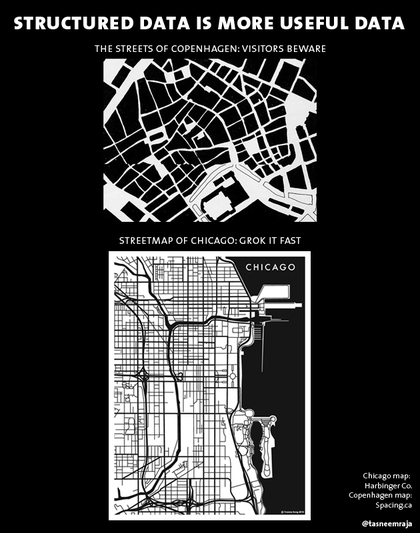Features:
2013 Wrap-Up, Part 1
A year’s worth of useful, excellent things from our readers and contributors

Fort McMoney, a documentary game
Just before Christmas, we asked you to submit one thing you found helpful or wonderful or excellent this year. The gist where we made the call grew into its own comment ecosystem of awesome links, and we’ve combined those submissions with the ones you emailed and DMed. There were too many submissions to run in a single post, so we’ll publish the second half tomorrow.
And in return for your links, we made you some GIFs. (Thanks, Blingee.)
Things to Read, Watch & Play

Chicago and Copenhagen street map comparison from Tasneem Raja
Props to Matt Wynn on launching Omaha Crime Report. Not just a map of crimes, but the ability to subscribe to alerts of incidents in your neighborhood.
—Reid Williams
NICAR. Especially I loved Ben Welsh and Jacob Harris’s lightning talks. And Amanda Cox’s R workshop, though I do not have a link for that.
—Alyson Hurt
Hollow: A Documentary and Fort McMoney.
—Brett Gaylor
Periscopic’s visualization of gun deaths in 2010 and 2013 You could customize the data presented in a number of ways i.e. combing demographics and age. But what was the most touching element of this visualization was how each death was noted and treated when you loaded the page initially: this was done with streaming curves that cutoff and changed color at the point of death. That was a great way of adding individuality and personalization in an otherwise large datasets in which individuals could disappear.
—Siyabonga Africa

Tasneem’s holiday spirit is unstoppable.
The Chicago street grid. It makes for a beautiful analogy to a well-structured dataset, very handy for teaching the fundamentals of data journalism.
If you had to live in a spreadsheet (and data journalism often feels that way), wouldn’t you rather it looked like Chicago than Copenhagen?
—Tasneem Raja
Things to Use
Sublime Text with SFTP. It meant never having to code within a CMS textarea ever again.
—Luke Seemann
It’s a small thing, I think it was this year I started using ImageOptim on all images I upload to Nieman Lab. Reliably squeezes out 10-30% of the size of jpegs / pngs / gifs without hurting picture quality. Every 30kb helps.
—Josh Benton
https://github.com/opencivicdata/ocd-division-ids.
—Derek Willis

Ben cannot help but celebrate.
Grove.io was a good addition to our little team in the past year or so, allowing us to have a group IRC chat up and running all the time. The service isn’t new, but it’s new to us. We get the serious benefit a low-friction way to communicate, complain about bugs, share links etc. Plus we’ve all grown closer to our robot friend copyboy.
Also, I’ve come to rely on the open-source monitoring service uptime to let me know when things go wrong with our production deployment. And we even made our own Grove plugin for it to drop a note in IRC when something crashes. It stands watch from a beat-up tower computer under my desk now that I’ve got it, I couldn’t imagine living without it.
—Ben Welsh

Tabula makes David really happy.
Close to home, but my colleague David’s Chartbuilder has completely transformed how we do things at Quartz.
—Zach Seward
Tabula has been the hours-saving chart-enabling magical tool that still leaves me in awe every time I use it … even though I probably pronounce it wrong.
—David Yanofsky
Started using GruntJS in all my projects in 2013. This tutorial from Chris Coyier was a perfect place to start.
Also, much love to the geoJSON team. Just want to give kudos for their hard work.
—Pippin Lee

Jeff loves winter.
My favorite thing this year is hands down Ragel, which is basically regular expressions on steroids. Well, technically it is a parser generator, but it doesn’t do recursive descent so you couldn’t easily write an HTML parser with it (though for lexing HTML you can go to town :)). The best part is it can emit source code everything from C to Ruby. Every time I get a weird file format from sources, that is more heavy than straight CSVs, I reach for it. It has become one of the most valuable tools in my toolbox.
For example, it came in super handy when parsing fixed width files from the Ohio Department of Corrections for our HIV story this year.
—Jeff Larson
Man, I could probably do a thousand of these. For inter-team communications, especially at a distance, we started using Slack this year, and it’s really transformed the way we work together and makes me happy on a daily basis.
—Dan Sinker
Field notes. Never leave home without one in my pocket, at least until I lose it on a bike.
—John Bracken

Michelle is ready for New Year’s Day.
Digital First Media journalists started using Tout, short-form video known for its ease in social sharing, in 2013 through a strategic partnership. Users can also create a widget with a hashtag to collect a series of specific videos in a player. No longer do we need to spend two hours on creating video: shooting and editing. It takes up to 45 seconds and shared in real time. We can stream them live on our websites through video players, share them via social media, and we get our audience involved, encouraging them to shoot 15-seconds Touts as content partners. Here’s my channel and here’s my media lab’s channel.
I also want to give a shout-out to RebelMouse. RebelMouse allows journalists, media organizations and the Fifth Estate the opportunity to curate content from a variety of sources—news feeds from media, Pinterest boards, Tweets via hashtags and handles, YouTube videos and/or channels, LinkedIn feeds, Facebook, Google+, Flickr, Tumblr and you can deliver news via live blogging. I’ve created microsites under our mastheads, as well as our media lab, on specific topics, such as the murder of Eastern Michigan University football player Demarius Reed, as well as the Affordable Health Care Act and the 50th anniversary of JFK’s assassination. We embed these pages on our news websites and our blogs.
—Michelle Rogers
Bonus Things
Tim’s Kitchen Tips, for teaching me how to cook.
—mobeets

2014 is Stijn’s favorite number.
My vote would be for spaced repetition. It’s based on the idea that people tend to forget things at pretty predictable intervals, and by reminding them just before they’re about to forget, people can soak up lots of new information in very little time.
A lot of people use it to help them learn a foreign language: you put your vocabulary in spaced repetition software like Anki, and it’ll give you a daily dose of perfectly personalized flash cards. Medical students use it to remember all of that anatomy, computer programmers use it to quickly remember the ins and outs of regular expressions or the standard library of their favorite language, musicians use it for ear training and elementary school students to memorize all fifty states.
Now that we can google for anything and everything we often forget how incredibly useful it can be to know things by heart. So, hooray for spaced repetition.
—Stijn Debrouwere
Similar to @ Alykat’s thoughts, I loved the strength of this community and the efforts of so many this year. I’ve mentioned in passing before, the efforts aim to collaborate, teach and learn instead of competing is such a testament to those working in this space. An obvious byproduct of that are the tools and methods and apps that are created.
—Chris Keller
Credits
-
 Erin Kissane
Erin Kissane
Editor, Source, 2012-2018.



